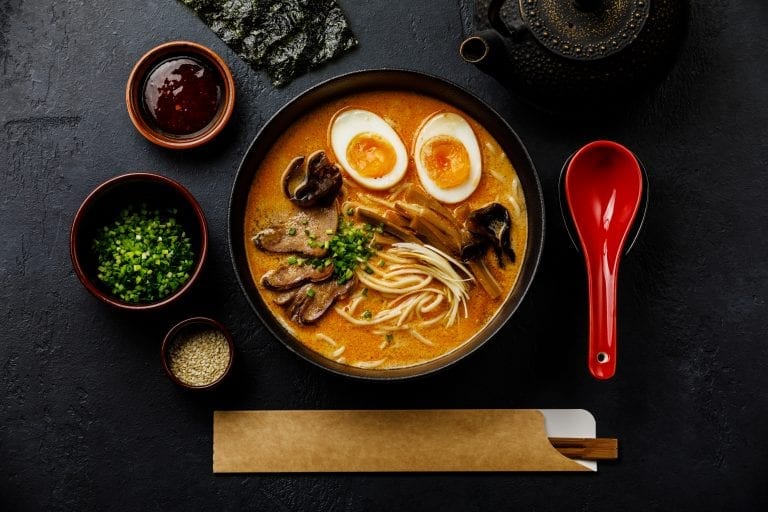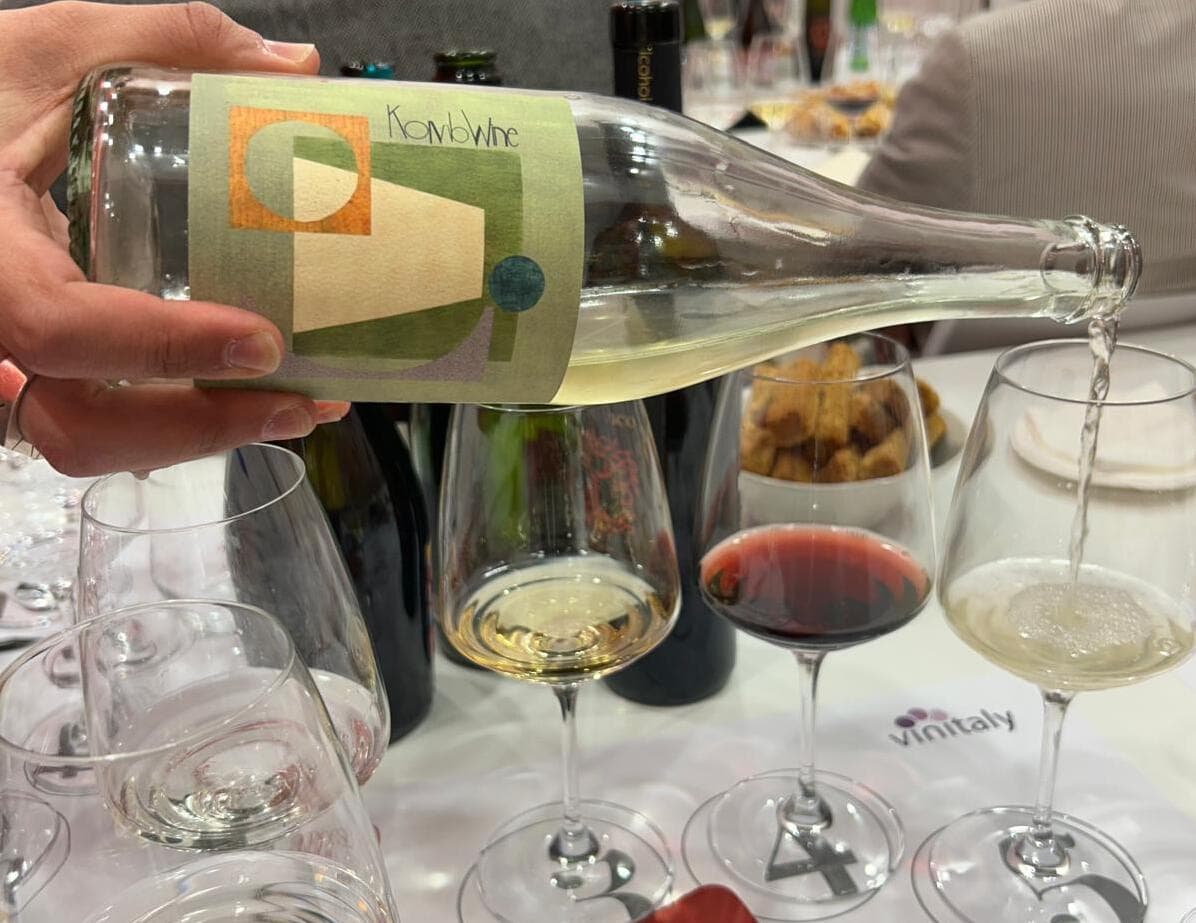Ramen. The Japanese soup with inimitable taste
An excellent ramen is recognised by the balance between its individual elements: the umami of the hot broth, the consistency of the noodles, the play of flavours and textures of the topping. Preparing it is an art, savouring it is an experience that sooner or later is worth doing. As long as you give up all formalities. The Japanese, in fact, have a completely different concept of etiquette from ours: according to tradition, spoonfuls are swallowed with a loud click of the tongue as a sign of appreciation; a very curious tasting technique, capable of putting even the most casual gourmets on the spot, so much so that a well-known Japanese food brand specializing in instant noodles, has seen fit to sell a practical anti-suck fork to dispel any embarrassment. But that's another story: let's now find out how ramen was born!
Chinese or Japanese? The true story of ramen
Although ramen has found fertile ground especially in the Land of the Rising Sun, where today it is widely consumed dish every day, credit for its invention is due to the Chinese. According to sources, the Chinese scholar of the Ming dynasty Shu Shunsui, who came to Japan during the 17th century as a refugee and quickly became adviser to the feudal lord Tokugawa Mitsukuni, is the one responsible for spreading the ramen culture. Since the house lord used to consume a simple udon soup at the beginning of the meal, Shunsui suggested that he enrich it with different ingredients, from vegetables to pork, in order to compose a single balanced dish. Unfortunately, however, no written evidence of the recipe has come down to us, and the fine line between reality and legend makes it impossible to ascertain the veracity of the hypothesis. More credible is instead the theory according to which, with the opening of Japanese port cities to foreign trade in the mid-19th century, the country discovered the existence of laa-mein, a Chinese noodle broth very similar to ramen, whose difference with ramen is the lack of topping.
Ramen lands in Japanese restaurants (and it's immediately trendy)
According to George Solt, a history professor at New York University and author of The Untold History of Ramen, the first Japanese restaurant to serve the dish was Rai Rai Ken in Tokyo, employing Chinese cooks in 1910. There was still no talk of ramen, however: the hot soup––made with noodles, roasted pork meat, nori seaweed and steamed fish––was offered to customers under the name of "shina soba." Decreeing its success was the satiating effect and the low price, which made it particularly attractive in the eyes of the working class during the period of industrial development in Japan.
Subsequently, the birth of machinery for the production of noodles and the rapid urbanisation of the country, closely followed by the spread of the great dining brands, contributed decisively to the rise of ramen. As for street vendors, it seems that they appeared in city markets at the end of WWII, to circumvent the rules on rationing of "luxury foods" imposed by government authorities. At that time, from a popular dish accessible to all, ramen first became an object of undeniable desire, then a leading product on the black market and, finally, a symbol of street food at bargain prices. And today?
Ramen. One dish, infinite number of variants
Volumes could be written on ramen-making techniques, and perhaps they would not be enough to list all the types available. Let's try, however, to deepen the discussion a little. The traditional recipe features a meat or fish broth flavoured with miso (a typically Japanese condiment made of fermented yellow soy and, sometimes, other grains) or with soy sauce (obtained from the fermentation of soybeans, wheat and koji mushroom). To enrich it, wheat flour noodles are commonly added, plus lices of kamaboko (finger food consisting of oily fish and surimi), seaweed, pork and spring onion.
Undoubtedly, the great success of ramen is due to the ability to customise the basic preparation through the choice of ingredients and noodle shapes that are always different: in Japan, everyone has their own preferences in terms of broth and noodles. Among the best known versions is tonkotsu, which stands out for its thick and creamy broth obtained from the prolonged boiling of pork bones and for the slices of pickled ginger as topping. Then there's shoyu, dark brown in colour, in which the flavour of soy sauce prevails, emphasised by nori seaweed and partially balanced by the freshness of bamboo shoots. Another variation is with miso, characterised by the sweet taste of the sauce and often served with spicy beans, sesame seeds and butter. Another is shio, which differs from tonkotsu in the broth filtering operation, which is light yellow in colour, and the garnish is with pickled plums and kamaboko. There is no shortage of vegetarian or vegan ramen options, in which meat and fish are replaced with foods rich in vegetable proteins such as marinated tofu, shiitake mushrooms, legumes and sprouts.
Recipes to make at home. Ramen by Umami - Japanese trattoria
It's time to move from theory to practice: we offer you two recipes by chef Giuseppe Milana of Umami, a Japanese restaurant located in the San Giovanni district in Rome. Choose the one you prefer and roll up your sleeves but, above all, honour the ramen ritual without inhibitions. As Giuseppe points out, the noisy tasting of noodles is part of the game, and will allow you to enjoy the umami much better.
Yasai Ramen (vegan ramen) recipe
Ingredients for 4
2 leeks
2 medium onions
3 carrots
4 celery ribs
8 dry shiitake mushrooms
200 g celeriac, minced
3 beets
1 head of garlic, sliced horizontally
200 g eggplant, finely sliced
1 daikon (optional)
1/2 bunch of chicory
100 g soy sauce
40 g kombu seaweed
200 g tofu
30 g fresh ginger, minced
30 ml sesame oil
1 bunch of previously boiled chard or chicory for plating
1 spring onion
300 g assorted vegetables (celeriac, carrots and courgettes), cut in lozenges
400 g fresh or instant noodles
Toast the vegetables in the preheated oven at 200°C for about an hour and, as soon as they are caramelised, place them in a large pot adding water, soy sauce, kombu seaweed, the green part of the celery leaves, leek, chicory, shiitake and ginger. Simmer for 90 minutes.
After this, filter and set aside the broth, saving only the shiitake, which must be squeezed and sautéed in a pan with oil and garlic. At this point, cut the tofu into cubes, sauté the vegetables cut into lozenges with sesame oil and salt and cook the noodles.
Once ready, place noodles in the bowls. Pour the broth and arrange the vegetables, mushrooms, sprouts, tofu and, lastly, the finely chopped green part of the spring onion on top of the noodles.
(i germogli non sono nella lista degli ingredienti…)
Crustacean ramen recipe
Ingredients for 4:
30 ml toasted sesame oil
2 garlic cloves
800 ml chicken stock
30 g white miso paste
20 g fresh ginger, grated
30 ml soy sauce
1 medium hot chilli pepper
3 fresh prawns
20 shrimp, completely shelled and deveined
500 g mussels
1 spring onion
30 g soybean sprouts
10 g naruto kamaboko
1 chard or bok choy, boiled
400 g fresh or instant noodles
8 shiitake or champignon mushrooms, pan fried with garlic and oil
Spicy sesame oil to taste
Salt to taste
Pour the toasted sesame oil, shrimp heads, minced ginger, garlic and chilli pepper into a large pot and sauté over low heat for about ten minutes, then add the chicken stock, soy sauce and miso paste. Cook over moderate heat for at least 90 minutes, stirring occasionally.
In the meantime, clean the prawns by deveining and removing the carapace of the tail but leaving the heads attached. Open the mussels in a saucepan with the white part of the spring onion (the green one will be used later) and the sesame oil. Keep the molluscs aside for the garnish.
Cook the prawns for a very short time in a pan or on the grill and season with sesame oil and salt. Once the broth is ready, strain it and set it aside. At this point, cook the noodles in boiling salted water (as you would with regular pasta), drain and rinse under cold water.
Compose the bowls of ramen respecting the order of the ingredients. First, pour in the noodles and broth, then place the prawns on one side and the previously shelled mussels on the other. Add the shrimp seasoned with spicy sesame oil and salt, which will cook slowly with the heat of the liquid. Finish the dish with the green part of the chopped spring onion, soybean sprouts, chard, naruto kamaboko and mushrooms.
Umami - Via Veio, 45 - 00183, Rome - Facebook page
by Lucia Facchini


 Versace opens a super hotel with an Italian restaurant. Here's what Donatella Hotel & Restaurant in Miami will be like
Versace opens a super hotel with an Italian restaurant. Here's what Donatella Hotel & Restaurant in Miami will be like At The Crown Tirana, service and quality at the highest levels
At The Crown Tirana, service and quality at the highest levels We tasted Komb(w)ine, the new product that combines grape must and kombucha. Here’s our verdict
We tasted Komb(w)ine, the new product that combines grape must and kombucha. Here’s our verdict What changes for the export of Italian wines to China under the new regulations?
What changes for the export of Italian wines to China under the new regulations? “Forget dealcoholised wines. The future is Komb(w)ine.” Moser and Ravizza present a new grape must-based product
“Forget dealcoholised wines. The future is Komb(w)ine.” Moser and Ravizza present a new grape must-based product






